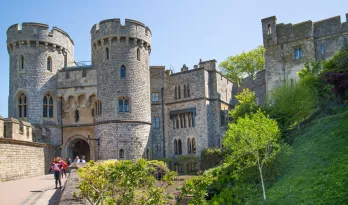Windsor Castle Facts: top 10 interesting facts
Built in the late 11th century, Windsor Castle is the oldest castle in the world that is still occupied. Of course, it holds many secrets.

1. It’s the largest and oldest inhabited castle in the world
When William the Conqueror had Windsor Castle built in the late 11th century, it was to be an indestructible fortress. He built the castle to be strategically located on the Thames, while ensuring Norman dominance around London.
At that moment, the royal family lived in the former palace of Edward the Confessor in the village of Old Windsor. Windsor Castle has been used as a royal residence in 1110 by Henry I (4th son of William the Conqueror). Since then, the castle has been the home of the British royal family, with no fewer than 39 monarchs residing there.
2. It houses the oldest kitchen in the country
The Great Kitchen at Windsor is the oldest working kitchen in the country, serving dishes since the days of Edward III around 1360. It has been in continual use for over 650 years, serving 32 of Britain’s 39 monarchs.
In order to keep the whole dinner service running efficiently, the clocks in the kitchen are always five minutes fast, to ensure that the King always gets her food at the right time.
3. Queen Elizabeth II slept in the dungeons during World War II
During World War II, London and Buckingham Palace were under constant bombardment. The Royal Family decided that Windsor Castle was the safest place for the young Princesses Elizabeth and Margaret.
Some nights, they were forced to sleep in the dungeons in case the Luftwaffe bombed the castle. The dungeons had reinforced bedrooms, all windows were blacked out and chandeliers removed.
4. It was Queen Elizabeth II's favourite residence
Windsor Castle was Elizabeth II's favourite place, she spent the vast majority of her childhood there. When she acceded to the throne in 1952, she decided that the castle would become her principal residence during the weekend. The private flats were renovated for the Queen Mother: Elizabeth Bowes-Lyon, her husband and their two daughters: Elizabeth and Margaret.
5. The Castle has 300 fireplaces
Each of the 300 fireplaces is under the care of the King’s fendersmith. He has been doing this for decades, having taken over from his father in 1984. It is a big job, which has to be done with a level of care and attention worthy of a king, and has therefore not yet been outsourced.
6. There are nearly 450 clocks
The castle's watch curator is responsible for the maintenance of all historical timepieces. Many of them have obsolete and highly complex mechanisms, which require a great deal of skill to keep them in working order.
The two busiest weekends of the year are the time change weekends. It takes about 40 hours of work to prepare it and about 16 hours to move them all forward by one hour in the spring. But moving the clocks back takes even longer. The restorer has to wind them up for 11 or 23 hours, instead of moving them back one hour. Despite its size, the castle is contained in one time zone, which makes things a little easier.
7. There are Changing of the Guards ceremonies
Windsor Castle has a Changing of the Guard ceremony, such as Buckingham Palace. A new group of soldiers takes over responsibilities for guarding the palace. This ceremony happens at 11 AM on Tuesdays, Thursdays, and Saturdays.
8. The Long Walk is nearly three miles long
The Long Walk was commissioned by Charles II between 1680 and 1685, when he had a span of elms planted. The walkway dates from 1710, laid out under Queen Anne. It is approximately 3 miles long (4.5km long) and marks the eastern edge of the town of Windsor. It is planted with 1,652 trees, 9 metres apart. The width of the two rows of trees is between 45 metres and 63 metres.
9. The Royal Family takes its name from Windsor
Saxe-Coburg-Gotha is the previous name of the Royal family. This name comes from a German dynasty. During World War I, an anti-German public sentiment was growing. So, George V changed the name of the royal house on 17 July 1917. The family name was changed to Windsor. The word has its origins in the Old English Windlesoren, which means 'winch by the riverbank'.
10. It is the burial ground for 10 of England's kings
10 of the 39 British monarchs have been buried in Windsor Castle. We can mention Charles I. He is the only British monarch to be tried and executed for treason in 1649, he was beheaded at Whitehall Palace.
Charles I is interred alongside Henry VIII and his favourite wife, Jane Seymour, in St George’s Chapel. Other buried Royal family members include Edward IV, Henry VI, Edward VII and Queen Alexandra, and George V and Queen Mary.